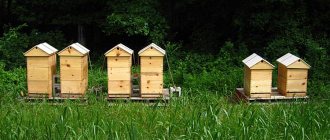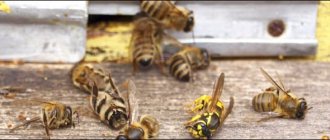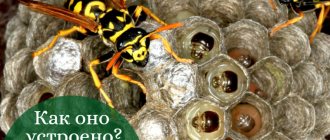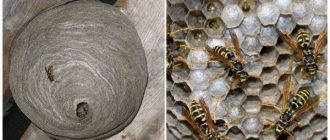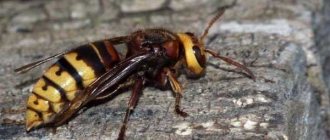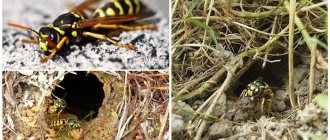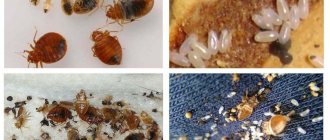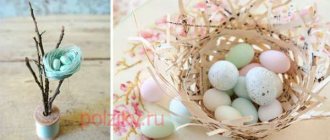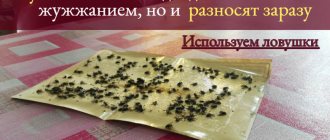Wasps are useful. These are one of the gardener's best helpers, because, in addition to berries and fruits, they feed on the larvae of flies and garden pests. So it’s not worth fighting these insects if they just live on the site. At least until there are too many of them. It's another matter if wasps have settled in the house. Then you need to get rid of them. And as soon as possible.
How to get rid of wasps under the siding of a house
Wasps often choose a place for themselves under the siding of houses and cottages.
How to deal with wasps in a country house in an inaccessible place, such as the siding of a house? This is where scents can come to the rescue. Essential oils of lavender, lemon balm, mint, rosemary, lemongrass or decoctions of garlic, tansy, and wormwood are used. The walls are impregnated with these liquids, and you can also use a syringe to fill the cracks in the walls. This method will help drive out wasps at least for as long as the smell persists. And while they are gone, the wall can be repaired so that there are no more cracks on it.
Note! In exterminating wasps under the siding of a house, methods that are suitable for fighting them in walls are also good - traps and sealing cracks. Everyone needs to know not only how to deal with wasps, but also how to prevent them from appearing in the house and country house.
Geranium should be placed on windowsills, as its specific smell is not only beneficial for the human body, but also repels insects. At your summer cottage, you can grow as many fragrant plants as possible, such as mint, basil and garlic. Well, if wasps do appear, then you should re-read the article and choose the appropriate way to kill unexpected hymenoptera
Everyone needs to know not only how to deal with wasps, but also how to prevent them from appearing in the house and country house. Geranium should be placed on windowsills, as its specific smell is not only beneficial for the human body, but also repels insects. At your summer cottage, you can grow as many fragrant plants as possible, such as mint, basil and garlic. Well, if the wasps do appear, then you should re-read the article and choose the appropriate way to kill the unexpected hymenoptera.
Repellent
The destruction of wasps in a dacha does not always involve exterminating them; you can scare away a family and force them to move. The location of the nest in the depths of the garden, at the end of the vegetable garden, does not require emergency action; their presence on the site does more good than harm. To do this, you need to know what to be afraid of wasps.
You can get rid of wild wasps in your area with a strong odor. The nest is watered with flammable substances - kerosene, gasoline, machine oil. Or lay out a soaked rag nearby. Insects do not like the smell of herring; they throw the head of a fish at them.
Bunches of peppermint, wild rosemary, and elderberry are hung in the attic of the dacha. A decoction of these herbs is periodically wiped across window sills, window frames, and doorways.
Wild wasps - what do they look like?
Bright yellow stripes on a black body are a special sign of insects. People believe that any wasp that lives in our flower beds or living in our gardens is wild. In fact, there are many subspecies of the pest. These are social and solitary wasps, glossy wasps and scolia, paper and road wasps.
And even huge hornets that do not have a distinct pattern on their body. The problem is that all these insects are very dangerous for humans, because when they bite, they inject a strong toxic poison under the skin.
Depending on the species, wasps may have a fairly long, elongated body covered with bright yellow stripes. The bodies of some representatives of the “stingers” sometimes have a uniform color, often black. And some subspecies can boast of a fluffy “coat”. All representatives of wild wasps have large membranous wings connected to each other. Thanks to this feature, they fly very quickly and attack their enemy with lightning speed, often chasing him for a long time.
It is not difficult to recognize the nest of wild wasps. Social wasps can take a liking to hollow trees. Paper wasps build shelters in the ground by digging deep, branching tunnels.
Some wild wasps weave so-called cocoons, which are attached on a special leg to horizontal and vertical surfaces. To reliably protect themselves from attack, they can organize a nest in any cavity, for example, walls, under roof sheathing, etc. Solitary wasps are content with small holes in the ground where they raise their offspring.
Found a hive of wild wasps - prepare for bites
Many people believe that wasps attack only if they are provoked, for example, by hitting the nest or trying to catch an individual with your hands. But this is a misconception. Insects defend their territory; at the slightest visible danger, they fiercely defend their offspring and the hive. And if tactile contact with a pest accidentally occurs, it will immediately attack. Unfortunately, a wild wasp sting can cause serious harm to health, especially if the attack is widespread.
In addition to the fact that they can carry E. coli, you should be wary of the following troubles:
- Severe pain at the site of the bite.
- Severe tissue swelling (allergies)
- Increased body temperature.
- Obstruction of the airways.
- Tearing.
- Fever and weakness.
- Anaphylactic shock.
There are cases when a person simply died after being bitten by these dangerous insects, especially their overseas “brothers”. The thing is that wasps, for example hornets, release strong poison through their sting when they pierce the skin. Of course, they don’t want to kill us, it’s just that in the wild this is how they paralyze their prey. To alleviate the condition of the bitten person as much as possible, he is given an antihistamine and pain reliever.
What do wild wasps eat?
Paradoxically, adult insects and their offspring prefer completely different diets. The wasp looks for sweet fruits, eats flower pollen, feasts on fermented berries, and is attracted to spicy strong odors. But the wasp larva is exclusively a meat eater.
Females have to hunt and catch small insects, spiders, and butterflies. So that the young can eat them, the wasp injects a toxin into the body of the victim, which paralyzes it. After this, the larva is able to eat the “food”. Some types of wasps make a kind of reserve from paralyzed insects, laying the larva directly on their body.
As soon as it hatches, it will start eating it.
How dangerous are wasps and what harm do they cause?
The main difficulty is that wasps are able to transmit danger signals to their relatives. If you crush a wasp at the moment of its bite, up to ten insects will fly to its aid to take revenge on the offender.
Wasp poison
The poison penetrates the skin at the moment of the bite. Everyone’s reaction to this substance is different and unpredictable: for some, the wound will swell slightly, while others will end up in intensive care with swelling of the upper respiratory tract.
Wasp venom contains substances such as:
- apamin and acetylcholine - affect the central nervous system and impair coordination;
- phospholipases - provoke inflammation and swelling of tissues;
- melitin - can cause tissue cell breakdown
If a wasp stings on the face, swelling of the soft tissues may begin, the eyelids and lips will become swollen. A bite in the neck and ear can cause suffocation and even lead to death if qualified medical assistance is not provided in time.
Often a wasp sting provokes angioedema and anaphylactic shock. Remember that not every person knows that they are allergic! It’s better not to take risks, but to start exterminating the wasps.
First aid for a bite
Wasps feed in garbage dumps, burial grounds, in street cafes and on open terraces in the country. Even if you do not experience swelling or an allergic reaction after an insect bite, you need to treat the bite site with hydrogen peroxide and apply ice.
If the victim's temperature rises above 39 C', it must be brought down to 37.7 C' before the ambulance arrives.
To relieve swelling and stabilize the general condition, you need to take an antihistamine.
Where do wasps live?
Wasps look for secluded places and build hives:
- in attics;
- under a roof in a barn;
- behind wall cladding;
- in closets with out-of-season clothes;
- in the ground;
- in the woodshed;
- and other places
Prevention measures
Wasps on the balcony are rather unpleasant neighbors. Anyone who has already fought with them once has already become convinced that it is better to take measures in advance to avoid such a neighborhood. Therefore, you should not wait until they settle on your balcony, but do something now. You can, for example, remove all unnecessary things from the balcony, and treat old furniture with detergents from time to time - wasps will not settle in clean places with the smell of chemicals. Seal all the cracks on the balcony tightly with mortar or putty so that wasps do not have the opportunity to penetrate into the hidden corner and establish their home there. Flower pots with soil can also be a place for wasp nests, so you need to get rid of them too - at least from the soil, which is not used in any way anyway.
First aid for bites
Compared to bees, which can only sting once, a wasp is able to make several stings at once, sending a portion of poison into the human body. The peculiarity of the bite is its alkaline reaction, so the bite site must be treated with substances with high acidity, for example, vinegar or citric acid. Wasp stings are especially dangerous for people prone to allergies. The result of bites from such insects can be anaphylactic shock, swelling of the larynx, suffocation and even cardiac arrest. On earth, 2% of people suffer from developing allergies to the bites of many stinging insects, including wasps.
Signs of a wasp sting include:
Anaphylactic reactions:
Therefore, it is important to know what needs to be done first in order to reduce negative feelings, preserving the health and even life of the victim.
How to proceed:
Source
Factors of destruction
Wasps should not be tolerated; they must be gotten rid of. They pose a danger due to numerous factors. If you find a wasp nest under the roof of a garage or house, you must destroy it immediately. To exterminate striped pests in the territory of your dacha, you can fight it with the help of baits.
The following factors contribute to the removal of wasps:
- They are prone to destroying crops in garden beds. Several individuals can destroy berry bushes and damage apple trees, pear trees and grapevines.
- Wasps carry infections by landing on freshly washed fruits. Often people suffer from the disorder without even thinking about what triggered the cause of such trouble.
- They show persistent aggression towards humans. An insect can sting about 5 times without saying goodbye to its sting. Wasps become especially dangerous when a person approaches their home. Children have a hard time with wasp stings, as they often have allergic reactions to insect venom.
Vespiary
Fighting methods
To understand how to deal with wasps that have settled under the roof, you need to follow some important rules. By adhering to them, you can avoid harm to your health. They are as follows:
- Before you drive wasps out from under the roof of your house, you need to warn your neighbors about the upcoming procedure. During this time, people should keep all windows closed and stay indoors.
- Wear waterproof clothing to avoid insect bites.
- All parts of the body must be covered, gloves are put on the hands, the face is covered with a specialized mask, and rubber boots are put on the feet.
- The choice of method for removing a wasp nest under the roof should be based on safety for others. One of these methods is the use of a smoke attack. This will help euthanize the wasps while the nest is being destroyed.
- It is better to poison insects at night, when they are less active.
- You should not deal with single individuals that have left the nest. When dying, they release a toxic substance that helps attract other members of the wasp swarm to attack.
Important! If a large number of wasps fly out of the nest, it is better to postpone the procedure to another time
Safety precautions when getting rid of pests
Wasps are aggressive insects that can regard any gesture as a danger to life. The nest is guarded by scouts and guards, and in case of danger they transmit a signal to others. When an insect dies, a special substance is released, which its relatives catch and rush to attack en masse. You need to remember all this when going on an operation to destroy a nest or wasp family.
- The work should be done in the evening, when insect activity has decreased. In the dark, they have difficulty oriented in space. But everything needs to be done as accurately as possible, since they hear the smell very well. They will rush to attack blindly.
- When performing pest control operations, you should not make sudden movements; all actions must be thought out in advance, and the necessary materials must be prepared. If one insect bites, you cannot kill it, because a whole swarm will fly out.
- When using an insecticide, you should remember that it will take a few minutes to take effect; spraying inside the nest can only anger the swarm. Therefore, it is advisable to use the product outside or use a plastic bag. It pounces on the nest and quickly ties it, blocking the exit.
If a swarm of wasps accidentally flew into your dacha, you need to get rid of the invasion, use smoke bombs, set fire to rubber, and build a fire. If the insects do not threaten to bite, you can leave them alone; after a while they will fly away on their own.
Any actions near the habitats of Hymenoptera require certain safety measures. All manipulations must be carried out in thick clothing that reliably covers the body. A bee net is placed over the head to prevent bites to the face, neck and head. It is best to destroy nesting sites in the dark, when all the insects are in the shelter and sleeping.
If you need to decide how to get rid of wasps that have infested the wall of a house, it is important to remember that Hymenoptera are very sensitive to light, so taking a flashlight with you is strictly prohibited. The only spectrum that representatives of this species do not respond to is red, so the flashlight can be painted over with paint of this shade or covered with fabric.
Precautionary methods for wasp control
Fighting wasps on your own is quite dangerous, so you need to be as careful as possible when carrying out any manipulations.
If time permits, it is best to get rid of a wasp nest when the wasps are still hibernating (autumn, winter, spring).
If you find a nest when the wasps are already active, then try to do all manipulations with it in the late evening or at night, after the wasps have flown into the nest for a night's sleep and are not so aggressive. When it rains, wasps are inactive and easier to control. To protect yourself, it is best to wear a beekeeper’s protective suit with gloves and a mask.
But if you don’t have such a suit, then at least wear thick clothes that completely cover your body, gloves and a gauze bandage on your face. Important! You need to approach the wasp nesting site slowly and carry out all manipulations without sudden movements or screams. If the wasps begin to fly out of the nest during the procedure, slowly move away from this place and hide in some building
You can begin work on getting rid of wasps again after a few hours, when the wasps have calmed down. Never kill individual wasps, even if they try to sting you. When they die, they will release substances that can provoke the entire colony to attack you.
To prevent the wasps from returning next year, the mark from the nest at the place of its attachment must be very well cleaned (with sandpaper, scraped off with a knife, etc.) and treated with some kind of antiseptic (potassium permanganate, alcohol, hydrogen peroxide, etc.) If you used aggressive or chemical substances, you need to wash your clothes and take a shower yourself to wash off any remaining substances.
Preventive measures against “house wasps”
To avoid the invasion of wasps into the attic and their repeated return after successful control, the owner of the premises should take preventive measures:
- remove empty nests in early spring and autumn, when wasps have not yet settled in it or have no longer settled in it;
- wipe the trace of the wasp's nest connecting to the ceiling with insecticidal preparations, a solution of potassium permanganate or hydrogen peroxide;
- do not store spoiled fruits that attract insects;
- timely seal cracks and holes in the attic and adjacent rooms;
- during house construction and renovations, carry out insecticidal treatment and sealing of all cracks, holes and voids;
- clean up regularly.
Maintaining the premises in acceptable condition and its cleanliness is the basis for preventing the appearance of insects.
Diversity of wasps in nature
There are a huge number of wasp species in the world. All of them belong to the order Hymenoptera insects, which have two pairs of wings. The size of adult individuals is from 10 to 55 mm, with males being smaller than females. Their mouthparts consist of strong jaws that are capable of tearing apart prey and gnawing layers of bark from trees. A distinctive feature of wasps is a thin stalk between the chest and abdomen, a kind of wasp waist.
All insects belonging to this family can be divided into two main groups: solitary and social wasps. The former lead a solitary lifestyle, often building nests in the ground or not building at all, preferring to lay eggs on larvae and spiders. Social or paper wasps are common striped wasps that buzz around gardens and parks. They live in colonies of several tens to thousands of individuals.
Reviews from summer residents about insect repellents
The deratization service will help you, or the sanitary and epidemiological inspection, or whatever you have in your city. We have Spetsbioservice doing this. They have special means, but dichlorvos is not guaranteed to help. Either they will be able to sell a suitable poison there, or they will come and process it themselves.
-Wolf-
https://www.babyplan.ru/blog/8126/entry-125409-kak-izbavitsya-ot-os/
Dichlorvos helps super! They instantly die from it. Place the nest in a bag, tie it and throw it away
Tsvetik-Svetik
https://www.babyplan.ru/blog/8126/entry-125409-kak-izbavitsya-ot-os/
In our dacha, wasps also built a nest in the toilet. The husband took a long stick, wrapped the end with cotton wool, and set it on fire. From the street he himself carried a stick into the toilet to the nest. It flared up instantly, they didn’t even have time to fly out! And the toilet was not damaged, by the way. It flared up and burned right away, only the ashes fell off.
ElVl
https://www.liveinternet.ru/community/901126/post357491090/#comment671631573
Plastic bottle, fill halfway with water. Or drop some honey, or pour juice from a watermelon/melon, or something else sweet. The wasps climb in, but cannot get out. Sometimes it fills 2/3 of a bottle
netesaandrey
https://forum.guns.ru/forum_light_message/89/1029594.html
dichlorvos helps a lot to fight wasps, the last 2 years have been like an invasion!
https://forum.guns.ru/forum_light_message/89/1029594.html
How to remove a wasp's nest from an inaccessible place
If the nest is in a hard-to-reach place, you can still get rid of the wasps inhabiting it, you just have to put in a little more effort.
Using a bag:
- You can cover the nest with a plastic bag, tightly gluing the edges of the bag to the surface so that the wasps do not have the opportunity to fly out;
- Then you need to cut off one of the ends of the bag and quickly spray some of the aerosols (dichlorvos, WD-40) or a solution from a spray bottle into the resulting hole, then close the hole;
- The entrance to the nest must also be closed;
- Leave the wasp house for a few hours and then you can remove it.
How to get rid of wasps in the house under the floor using carbide If possible, try to insert a small piece of carbide into one of the nest holes and then pour water on it. Wasps die very quickly from the poisonous gas released when carbide interacts with water. To protect yourself from inhaling this gas, immediately after pouring water, move away to a safe distance or cover the nest with a bag.
How to get rid of wasps in your home between logs: This method requires patience.
- Try to use a vacuum cleaner to suck out as many wasps flying into your home as possible;
- Then spray the entrance hole of the wasp's nest with any flying insect control spray or WD-40;
- Seal the entrance to the nest.
If not all wasps die, then repeat the procedure with a new entrance to their nest between the logs.
Caution is paramount
The main rule to remember is: wherever there is a wasp nest, a person is in danger. He may be bitten for no apparent reason, completely without reason. At best it will be a small bite, at worst it will be numerous bites with an allergic reaction and swelling. In order to get rid of wasps once and for all, it is not enough to simply find the nest and eliminate it, you need to understand the reason for the appearance of uninvited insects on your site.
How to destroy a wasp's nest
You can often see wasp nests in your dacha. Wasps cause inconvenience not only to humans, but also to plants. They are capable of carrying various infections, often of an intestinal nature. These insects also threaten the harvest, especially if grapes grow on the site.
HOW WASPEN NESTS APPEAR
Nests are built by infertile females; they worry about their queen and her offspring, protecting them from strangers. Chewed natural material is used for construction. Typically, wasp nests are located in a dry, dark place (tree, attic, hollow). Wasps love sweets (drinks, honey, watermelon, jam and much more), flower nectar and ripening fruits. Wasps often take honey from bees.
HOW TO DESTROY A WASPEN NEST (THE MOST EFFECTIVE WAY)
Wasps cause a lot of trouble to humans, and in order to get rid of them, it is necessary to destroy their nests
It is very important to follow safety precautions here, otherwise if you act carelessly there is every chance of being bitten. It is better to remove a wasp nest in the fall or, if you need to act urgently and there is no way to wait, only at night, when all the individuals are in place and sleeping
It is extremely unsafe to carry out such an operation during the day. Before entering the “battlefield”, put on protective clothing; the best option would be a beekeeper’s suit, but not everyone has one, so wear everything that can cover all parts of the body. For the face, use a mesh. Think about how you can quickly help in case of defeat.
Another effective way to destroy a wasp nest is to take a plastic bag, treat it with karbofos or any other insecticidal preparation, very quickly pull it over the nest and cut off its fastening. Then tie the bag tightly and leave for several hours. Treat the attachment point with insecticide or hydrogen peroxide. If it is not possible to cut off the nest, then the treated bag is attached with tape on top. Only the bag must be tight, otherwise insects will gnaw through it. Also treat the area around the nest with an insecticide.
Before carrying out an operation to destroy a wasp nest, it is recommended to first reduce the number of individuals. To do this, treat the nest with the chemical “Moskitol” or any other drug designed to combat wasps; it will be good if the stream of the drug can be directed directly into the nest itself and the exit can be quickly plugged with a rag treated in the same preparation. For safety, wear a mosquito net and gloves over your face.
After using chemicals, do not forget to wash your hands well with soap.
When, while destroying wasp nests, a bite still occurs, you must immediately take an antihistamine (suprastin), and to relieve swelling, apply a cotton pad soaked in ammonia diluted with water (1:5) to the site of the bite.
FROM OS BURNING
Pour gasoline or any other flammable hornet's nest and burn it. The method, of course, is inhumane and ineffective. It can only be used in non-residential premises and not on trees.
TRAPS AND OTHER WASTE CONTROL PRODUCTS
It is especially convenient to use traps in places where approaching a wasp nest is difficult; in this way, you can reduce the number of individuals, but you will not be able to destroy the nests. Syrup and honey cannot be used in this case, since bees will begin to fly in with the wasps and will also die. Use only fermented products and old jam in traps. Change the contents in traps regularly.
1. Treat watermelon or melon peels with insecticidal preparations that do not have a strong odor (“Lambda-Zone”, “Delta-Zone”, “Smelnet”), place them near a compost heap or wasp nest. Wasps will fly to the smell and die from eating processed food.
2. Cut off the neck of a plastic bottle, insert it into the ground, pour in the spoiled compote and add boric acid to it. Once trapped, it will be difficult for the wasps to get out of it, and those who succeed will not have long to live, about 2 hours.
3. Apply medium-thick glue to a sheet of cardboard and place a piece of meat or spoiled fruit in the center. The wasps will begin to fly in and stick to the cardboard.
4. Many summer residents, if the wasp’s nest is in the ground, pour boiling water in a large volume (about a bucket), after which they fill the hole with earth and compact it well. You can put a piece of roofing felt on top, then press it down with stones or bricks.
Wasps may return again in the spring, without finding their home, they will begin to build a new one next to the old one. Therefore, the entire area near the nests must be treated with kerosene or an insecticidal agent, for example, Sinuzan.
Methods for getting rid of insects
Hornets - how to get rid of them in the house
When the nest is found, we can assume that half the work is already done. What to do next? There are both humane methods of getting rid of wasps, and those that are aimed at their complete destruction.
Important! Before you “start a war” with wasps, you need to choose the most closed clothing possible. A beekeeper's mask will come in handy. After all, when a person attacks a hornet’s nest, you need to be prepared to be defended.
How to repel insects:
- Smoke. Smoking out insects is one of the oldest ways to keep insects out of your home. However, this method is currently rarely used. Firstly, it is a fire hazard, and secondly, the smell of smoke will remain in the apartment for a long time.
- Planting plants with a high content of essential oils: mint and lemon balm, basil, wormwood, various types of geranium. The fact is that a high concentration of essential oils gives these plants a bright smell, which insects also smell. Only if for a person it is most often pleasant, then for other creatures it is disgusting. Therefore, it would obviously not be amiss to plant these plants in the house, even in a pot.
- Ultrasound. Wasps are afraid of ultrasound, so special devices can scare them away.
And, if there are not enough ways to survive wasps from the house, then there are much more ways to completely exterminate them:
- Water. You can either flood the nest with cold water or throw it into a container of boiling water. The destruction of the insect colony in the house is thus guaranteed.
- Insecticides. There are a great many of them. Most often they are produced in the form of aerosols. Simply spray in the right place. There are also various powders, poisonous baits and even liquids.
- Bottle traps for wasps. To make it, you just need to cut off the neck of the bottle, turn it over and insert it back. Then you should prepare a solution with an attractive smell and add boric acid to it. The trap is ready. All that remains is to put it in the right place and wait.
- Dichlorvos and other analogues of this product will be very useful when fighting wasps.
- Gasoline and kerosene. These substances need to be poured into a spray bottle and sprayed onto the nest.
Wasp traps
But the most reasonable option is to combine different methods of fighting insects. It’s not enough to simply poison them; you also need to destroy the nest and place as many traps as possible throughout your summer cottage.
What to do with ground wasps?
Ground wasps differ from their relatives in their large dimensions. They make their homes underground. In fact, there are a lot of varieties. In addition, not finding a more suitable place, the most common representatives of this type of insect place their homes directly on the ground. How to destroy such a wasp's nest?
Fill the passages with cement
A radical method that will require a significant amount of consumables. Dilute sand and cement in a ratio of 1 to 3. When filling insects’ homes, you need to take into account the possibility of hidden passages. A small amount of solution will only clog the outlet. Even if he is alone, the wasps will gnaw the road or dig a workaround.
Flood the insects' home with water
It is most effective to use boiling water for such purposes; large volumes of hot liquid need to be taken care of in advance. Most often, about three buckets are enough, but if the nest is huge, then the required amount of water can increase 2-3 times.
Carbide
Wasps are experienced builders; sometimes the distance between the entrance and the home stretches several meters. There is no point in flooding the inputs, but there is another solution. After pouring a small amount of water, pieces of carbide are placed in the entrances. After this, the entrance is closed with a rag soaked in gasoline or other petroleum product. As a result, toxic smoke will penetrate the hive and poison the local inhabitants.
Finally, one more piece of advice: before destroying a wasp’s nest, warn your neighbors. During this time, they should close the windows and not go outside unless absolutely necessary.
Wasp nests are a common sight on balconies, in sheds, under sheds and in other places near people. In addition to the general troubles that wasps bring, their stings can be deadly for people who have allergic reactions to them. A wasp's nest seems harmless, but having one near a house where people live is unsafe. The reaction of wasps to a person who is close to the nest is unpredictable. Sometimes insects try to protect it and behave aggressively. Near a wasp nest, there is always the possibility that wasps may attack a person for no reason. This is why many people have a question: how to get rid of a wasp nest?
If a wasp nest appears inside or near your home, this is an unpleasant situation.
Professional insecticides
The preparations are used in special cases for spraying the walls of a house in a summer cottage, garden plot, country house, and outbuildings outside. The concentrates are extremely toxic and retain their properties for up to 20 days in the absence of heavy rains. The maximum effect lasts 2 hours. Spray the walls, window sills, porch, balcony.
Professional insecticides for wasps
The concentrated solution is also used for spraying the nest, pouring it into cracks in the floor or wall. Odorless drugs are added to the bait - Delta Zone, Lambda Zone. Products are purchased in specialized stores and ordered online. Cost from 300 rub. for a small bottle.
Effective means:
- Executioner;
- Tetrix;
- Get;
- Sinuzan;
- Cucaracha;
- Diazinon.
The products are harmful to all insects. In addition to flies, horseflies, wasps, and hornets, beneficial creatures are also killed. Application must be justified.
If you don’t know how to get rid of a swarm of wasps in your home most effectively and safely, pay attention to the universal method. It is based on the use of insecticidal drugs. Currently, they are presented in sufficient assortment and abundance in hardware stores. You can choose any of the following:
- “Delta Zone”;
- "Executioner";
- “Karbofos”;
- "Diazinon";
- "Tetrix".
https://www.youtube.com/watch?v=SUmgnk6o2P0
These are time-tested, affordable drugs. Recently, a drug such as Aktara has been increasingly used to combat unwanted insects. Its price is slightly higher than the cost of its closest analogues (100 rubles per package of 4 g). But the efficiency is at the highest level. Of course, events require some preparation, primarily informational.
We invite you to familiarize yourself with How to fight aphids - effective folk remedies
“Delta Zone” and all of the above drugs are available in water-soluble form. All that is required of you is to strictly follow the instructions indicated on the package. After the miracle remedy is prepared, prepare a thick plastic bag, making sure there are no slits or holes. The size of the package should be identical to the size of the hive. Pour 200 ml of solution diluted in the specified proportion into the bag.
And finally, the most serious and crucial moment - the bag with the solution must be placed as quickly as possible, at the same time carefully placed on the nest, and in such a way that the possibility of wasps getting out is excluded. If the wasp's home is under the roof, then it is better to glue the neck of the bag to it with tape, thereby ensuring better fixation.
To be sure, before removing the bag, move it - if you don’t hear the characteristic buzzing sound, it means the wasps are dead and your goal has been achieved.
How to deal with wasps in a wooden house
The first thing that owners of wooden houses should remember is that methods involving ignition and the use of kerosene and gasoline are absolutely not suitable for such buildings. This may cause a fire. Otherwise there are no restrictions.
The algorithm for getting rid of insects is something like this:
- Find and destroy the nest.
- Poison the remaining individuals using traps.
Important! When a nest is discovered, it is best to fight insects at night, as there is a greater chance that all individuals will be in the house. To kill wasps once and for all using insecticides, you should follow these step-by-step instructions:
To kill wasps once and for all using insecticides, you should follow these step-by-step instructions:
- You need to take a large plastic bag and pour 1 tbsp into it. special product and with a sharp and quick movement put it on the socket. All that remains is to fix the bag as firmly as possible so that the wasps have no chance of escaping. After this you need to wait a while, 2-3 days is usually enough. After this, the package can be removed. And, to make sure that the insects have died, they first knock on the bag: if the blow is not followed by a buzzing sound, then you can safely remove it.
- In parallel with the destruction of the nest, poisonous traps are placed. They are made from plastic bottles. Usually beer, kvass or sour compote is poured inside and poison is added. Special adhesive insect repellent tapes will also help to save you from isolated insects.
How to deal with wasps in a wooden house
Use of traps and baits
Traps and poison baits are especially convenient when it is too difficult to get to a wasp nest or if the wasps fly into the house from somewhere far away (a nest outside the house or land).
It should be remembered that the food in the bait should be attractive only to wasps, but not to bees, otherwise these beneficial insects will die along with the wasps. Therefore, you can take fermented sweet foods and drinks, and avoid using sugar syrup and honey.
Closed traps
Devices for catching insects can be purchased or made independently. It’s easy to make a good trap from a plastic bottle with your own hands. To do this, remove the lid from it, cut off the upper third, then the cut part, neck down, is tightly inserted into the lower part. Just above the middle of the trap, holes are made for rope or wire “handles”; the structure will be suspended from them.
To make a trap, you need to take a plastic bottle and cut off the neck
The wasp’s favorite food is placed inside the trap - fermented jam, slightly rotten juicy sweet fruits, beer, kvass. Fermented stuff attracts wasps, but bees are indifferent to it. You can add boric acid to the bait (wasps die from it) or odorless insecticides (for example, Lambda-Zone). Toxic substances are added so that the insects die faster and cannot cause harm when it comes time to change the contents of the trap.
The traps themselves should be placed where the wasps are most often visible, and if the location of their nest is known, then not far from it. When there are a lot of insects on a plot of land, traps are placed on every two to three dozen square meters. The traps are cleaned as they become filled with insects; the contents must be regularly replaced with a fresh portion.
Glue traps
Glue-based traps can also be purchased at hardware stores or made yourself. To make it yourself, you will need a sheet of cardboard and Alt, RaTrap or similar glue. The glue is applied in a layer of medium thickness to the entire sheet of cardboard, and bait (a piece of meat, fish, rotten fruit) is placed in the middle of the sheet. The wasps will stick tightly to the trap and will not be able to free themselves.
Poisoned baits
The same food is used for baits as for traps, but the food is always poisoned with odorless insecticides (so that nothing alerts the wasps). For this purpose, for example, effective drugs “Lambda-Zone”, “Delta-Zone”, “Empire 20”, “Smelnet”, “Xulat-S25” are used. Boric acid is slightly less effective, but it is also suitable. The bait is placed in different parts of the house or summer cottage on unnecessary dishes. Wasps that eat such bait die within a few hours.
Where can you find a wasp nest?
It is necessary to detect, but it is not always possible immediately. The reason for this is the love of these insects to settle in dark places where there is no scorching sun and drafts. Therefore, their hive is not always in plain sight; often it is securely hidden where it would be difficult to destroy:
- in attics;
- in the crown of a tree;
- under the eaves;
- in the ground (in abandoned holes);
- in wall cavities;
- in pipes or between them, etc.
Limited access to such places immediately deprives a person of the opportunity to destroy a nest using relatively simple methods. As a result, the only options left are when you do not need to remove the hive from its attachment site, but use remote methods to solve the problem.
What nuances need to be taken into account?
If the wasp's nest is located on a balcony or loggia, or in an apartment, we send everyone in the house for a walk, and use a pan of water or insecticides, or maybe vinegar.
If there is a wasp nest in a house, including a wooden one, you need to be more careful when handling flammable substances - try expelling the wasps with boiling water.
If the nest is in the attic, in the wall, under the roof of the house or under the floor, bait traps and professional products will help us.
If the wasps just came to visit you and did not make nests near you, they may be wild. In this case, you need to spray some sweet fruit that has begun to rot with insecticides, and take such a “delicacy” away from your home - the wasps will eat the poison and die.
Bottle trap drawing
The device is the simplest.
To create a trap for killing wasps and hornets, you will need a regular plastic bottle, the neck of which must be cut off with a knife. It is better to initially take a larger bottle, for example 5 liters, so as not to clean it every 2-3 days. Next, the resulting funnel is inserted into the container and secured, and syrup or any other sweet bait is poured into the hole. To make the effect better, an insecticide is added to the bait. The principle of operation of the trap is simple - following the sweet smell, the insect falls through the neck of the funnel into the bottle, from where it cannot escape.
This is important : if traps are used in an apiary, then in order not to attract honey bees (our true workers and helpers) into it, beer or kvass is used as bait.
Traps of a similar design can be purchased ready-made in stores, but given the simplicity of their manufacture, there is little point in purchasing them. This is an option for very lazy summer residents.
Dangerous neighborhood
At a summer cottage or in a country house, the harvest of sweet berries and fruits is at risk. The peak of wasp activity occurs in the second half of summer, when the offspring have grown and require food.
Wasps like to live in dry, ventilated places
Ripe berries and fruits, especially grapes, attract wasps with their sweet juice. Insects can cause significant damage to crops. They cause no less damage to apiaries, attracted by the sweet smell of honey. They will not disdain leftover food from the table and garbage, simultaneously transferring germs and pathogenic bacteria from the trash heap.
Wasps can cause significant damage to fruit crops
The wasp's sting does not have serrations like those of bees and does not remain in the body of the victim. After being bitten, the insect does not die and can use its weapon repeatedly.
A wasp sting leads to swelling and is dangerous due to allergic reactions.
Traditional methods against wasps
If wasps appear in your garden plot, then you need to start fighting them immediately. It is best to do this in the dark. Then the insect becomes slower and less aggressive. This gives a person a certain head start. It is also prohibited to use any light sources that are sure to attract insects. Try to prepare everything in advance and create the conditions for successful orientation. Among the most popular methods of struggle are:
- Dishwashing detergents. This handy remedy, diluted with water, allows you to quickly deal with pests at home. When the composition gets on the wings of an insect, it stops moving and slowly dies. Create a weak detergent solution using boiling water and mix the ingredients thoroughly. After this, start spraying. If you need to deal with a nest, pour the cleaning solution into a spray bottle. Next to this, direct a stream into the hole and pour as much product as possible into it. On average, the entire procedure takes 10-15 minutes. Keep in mind that you will not be able to kill all the pests at once. Therefore, you will have to do several repetitions.
- Application of smoke. Smoke is something that perfectly repels absolutely any insects. With its help, you can quickly rid your area of wasps and insects. To do this, build a fire directly under the nest. The coming smoke will suffocate the wasps, as a result of which they will leave the shelter. When you are sure that the nest is empty, tear it off and burn it. Try to throw leftovers away from your home. Don't forget to keep a bottle of detergent handy, as unwanted tenants can fly out at the most inconvenient moment.
Article on the topic: Beetle that eats wooden houses
- Water. You can drive wasps away from your home very simply - just drown them. To do this, remove the nest from the surface in advance. Do this very carefully, take a thick fabric bag and put it on the nest. Once you have done this, you can tie the bag and remove the hive. Place it in the water and be sure to press it down with a stone. It is best to leave it all overnight to ensure that the pest is killed. Remember that the method for removing wasps is not suitable for inattentive and clumsy people.
- Boric acid. This is a white powder that is usually used not to control wasps in the garden, but to kill ants and cockroaches. The substance also has a detrimental effect on flying insects, including striped hunters. Boric acid is always added to all pest traps. You can create a trap on a tree - just hang a cut bottle and fill it with sweet water with the addition of boric acid. To kill individuals of the earthen species on the site, you can thoroughly water the entrances to the nest with a solution of 10 liters of water and 100 grams of boric acid. Keep in mind that this is a completely safe product that will not harm your plants. You can kill pests with boric acid very quickly.
- Gasoline, kerosene or other flammable substances. They need to carefully process the nest and spill the insides. Once you complete this process, the nest must be carefully set on fire. Keep in mind that you need to act extremely carefully so as not to get hurt yourself. If you don't know how to kill earth wasps, use this method.
- Hot pepper. If you hang a bunch of this spice near your house, terrace or any other place, you can ward off pests. The pest really doesn’t like their pungent smell.
Calling professionals
For certain reasons, some people cannot cope with wasps and destroy their nests on their own. In this case, you can contact and call a specialized service that will destroy the interfering insects.
However, when contacting professionals, you need to know some features of their activities:
- The cost of calling specialists ranges from 1000-1500 rubles for exterminating wasps in urban areas and from 2500 rubles for exterminating them in suburban areas. Moreover, for virtually all companies, the price of the service depends on the distance of the dacha plot from the city.
- It is recommended to use only those companies that guarantee that the insects will not reappear. Most organizations have a warranty period of 1-2 years.
- In some localities it is not possible to call a specialized service. In this case, you can ask for help from the SES or the fire service, but it must be borne in mind that fighting wasps is not their direct responsibility, so the service is provided exclusively by prior arrangement and usually specialists do not arrive immediately.
Burning out the nest
Burning down the home of unwanted neighbors is one of the most effective methods of getting rid of them, if conditions allow you to put this method into practice.
However, before using such measures, it is necessary to take into account some features:
- The process itself is quite simple, since wasp nests are made of a special material that they extract by chewing tree bark, its structure is closest to cardboard. Therefore, it is enough just to pour gasoline or other flammable substance over their shelter and then set it on fire; complete burnout will occur in just a few seconds.
- Initially, you need to make sure that this method is safe. The walls and ceiling surface should not be made of wood, and it is also necessary to ensure that the cladding is made of fire-resistant material, so as not to accidentally start a fire.
- It is most advisable to resort to burning if the nest is located on a stone surface or if the earth variety of wasps is being fought.
- When using this method in industrial plants or logistics centers, it is necessary to make sure that there are no flammable substances or materials anywhere nearby.
Anti-wasp drugs, their action and use
The chemical industry produces effective products that are aimed at repelling and destroying wasps.
| Drug name | Action | Application |
| Raptor | Affects the gastrointestinal tract of insects, paralyzing the nervous system. | The aerosol is sprayed into the nest. After the paralytic effect of the main substance on the wasps, the nest is removed and placed in a bag. All that remains is to burn the wasp's house. |
| Smelnet | Odorless microcapsules kill insects. | Place the product in hard-to-reach places at home. The drug is effective for 8-9 months. |
| Karbofos | It is toxic to wasps. | Prepare the solution according to the instructions. They lower the nest into a container with liquid, trying to drown it along with the inhabitants. |
| Get | The pale pink suspension contains the toxic substance chlorpyrifos. It has a paralytic effect on the nervous system of wasps. | Mix the powder with sweet juices or sugar, honey. Place the dish in an open place. |
| Commander | The drug is based on imidacloprid, a substance toxic to wasps. It has high penetrating ability, destroying insects in nests and in the ground. | Prepare the solution before starting treatment. The substance acts for a long time, for 2 weeks. |
Choose a chemical depending on where the wasp nest is located.
You can learn how to get wasps out of the attic from the video:
Insecticidal pesticides
The most effective remedy is chemical insecticides designed specifically to kill insects and, in particular, wasps. They bring almost instant results. After about 15 minutes after treatment with them, you can begin to remove the hive: the vast majority of the individuals in it will already die.
Each product has its own individual characteristics and recommendations for use, which you should definitely read before starting work.
Aerosols and sprays
Aerosols and sprays are the most popular form of insecticides, of all the options than poisoning wasps yourself. Thanks to the design of the can, you can treat insects at a distance and reach secluded corners. Most of these products contain substances from the pyrethroid group. The method of their penetration into the wasp’s body is contact-intestinal. Soon after infection, paralysis occurs and the insect dies due to stoppage of organ function.
- COMBAT PowerSpray allows you to spray insects and their hives at a distance of 1 m. According to the instructions, it does not pose a threat to the health of humans and pets, so if you need an effective way to get rid of wasps in your country house, this spray will be an excellent purchase. It has a pleasant smell with a subtle aroma of pine needles, which quickly dissipates after spraying.
- "Dichlorvos NEO" is similar to its famous predecessor only in name. In contrast, the modern version does not have a pungent odor. The composition includes a triple formula of poisons, which in combination with each other provide the desired result.
- Aerosol from MOSQUITALL “From wasp nests” is a professional means for fighting wasps. High performance is ensured by the presence of two powerful pesticides in the composition: biollethrin and cypermethrin, so Mosquitol can only be used in non-residential premises and outdoors. An important advantage of the aerosol is that it is sprayed at a distance of up to 6 m from the nest. For example, this is a great way to get rid of wasps on a balcony or open veranda.
- "Raid", like "Dizlofos NEO", contains 3 toxic substances. According to the manufacturer's instructions, the product is approved for use in residential areas. But after processing, thorough ventilation will be required.
Article on the topic: Why do you dream about an unfinished wooden house?
These aerosols and sprays can be purchased at a hardware store or a special section of a supermarket.
Concentrates
Less commonly, concentrates are used to control wasps in everyday life. They must be diluted in a large amount of water and used to spray the nests with a spray bottle. Their use is rational if several nests are found on the site, and the aerosol can may not be enough for everything.
List of popular concentrates:
- “Get”, which contains the organophosphorus compound – chlorpyrophos. It is a systemic insecticide. It has a microencapsulated structure: the smallest particles stick to the legs and body of the wasp, so before inevitable death it can infect other insects.
- "Delta zone" with the active ingredient deltamethrin. It enters the body through the intestinal contact route. “Delta-zone” is sold in 50 ml bottles.
- "Karbofos" is produced in the form of a liquid concentrate powder. The substance has a significant drawback - a pungent odor, so with the advent of analogues it is used less and less.
- “Executioner”, which includes the organophosphorus compound “fenthion”.
- Tetrix is an expensive concentrate used in professional processing. Very effective, but also toxic. You can purchase it by finding an intermediary on the Internet, because Tetrix cannot be found on the open market.
When using concentrates, the universal guidelines for the use of insecticidal chemicals should be followed.
